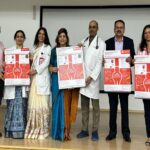“Diabetes and heart problems are comorbid conditions which will also see an increase”
New Delhi, May 25, 2018:
About a quarter of the global population will be obese in 27 years from now, as per recent research. It is expected that 22% of people in the world will be obese by 2045, up from 14% in 2017. The prevalence of diabetes is also expected to increase from 9.1% to 11.7% by 2045. One out of eight people around the world are likely to suffer from Type-2 diabetes. Unless changes are made both at the personal and global levels, the costs and health challenges will only magnify.
Obesity is identified as a medical condition marked by the accumulation of excessive body fat with negative health impacts. It is generally reported in terms of body mass index (BMI), a value obtained by dividing an individual’s weight by the square of their height. A BMI beyond 30 kg/m2 is considered obese, while a value between 25 and 30kg/m2 is defined as overweight.
Speaking about this, Padma Shri Awardee, Dr K K Aggarwal, President, HCFI, said, “Obesity is the mother of conditions such as diabetes and heart problems. India faces a dual burden. On the one hand is malnutrition and on the other is obesity. What makes obesity in India different from the rest of the world is that in our country, it is marked by the ‘Thin-Fat Indian Phenotype’. This means that there is a higher proportion of people with body fat, abdominal obesity, and visceral fat, in comparison with Caucasian and European counterparts. Hence, world obesity generally reported in terms of waist circumference, and a BMI beyond 30, significantly underestimates the prevalence of obesity in India. Indian obesity needs to be estimated according to a lower threshold of BMI 25. Additionally, even a normal BMI of up to 23, might show higher instances of isolated abdominal obesity.”
Two primary culprits of obesity include a sedentary lifestyle and unhealthy eating patterns. The consumption of processed food has increased manifold. This, combined with untimely working patterns and lack of physical activity, make the situation worse.
Adding further, Dr Aggarwal, who is also the Group Editor of IJCP, said, “The traditional Indian diet is rich in carbohydrates. People consume large quantities of rice, rotis, and even bread. Apart from this, there is widespread availability of fried and unhealthy fast food today, which are all contributors to empty calories in the diet. Indians are caught amidst all this and therefore, the increase in the prevalence of obesity does not come as a surprise.”
Some tips from HCFI
- The key to weight loss is reducing how many calories you take in.
- The concept of energy density can help you satisfy your hunger with fewer calories.
- To make your overall diet healthier, eat more plant-based foods, such as fruits, vegetables and whole-grain carbohydrates.
- Make exercise an important part of your daily routine. Start slow and increase the duration as you go along.







